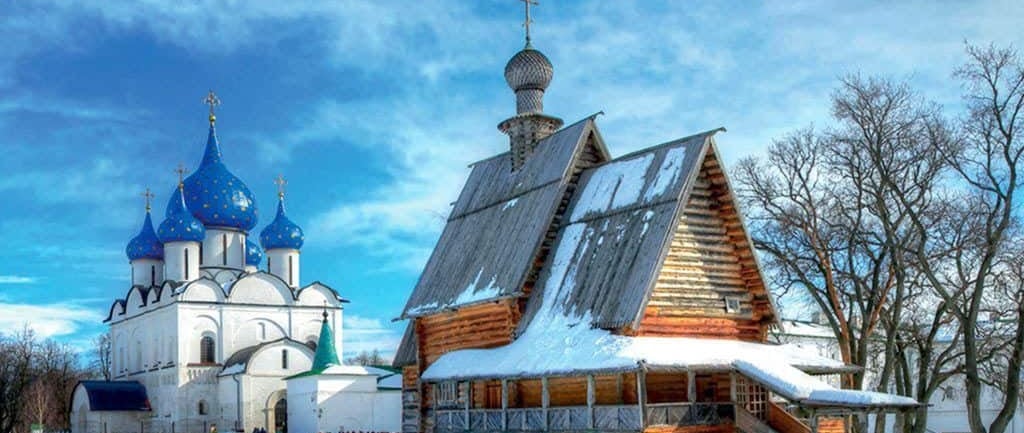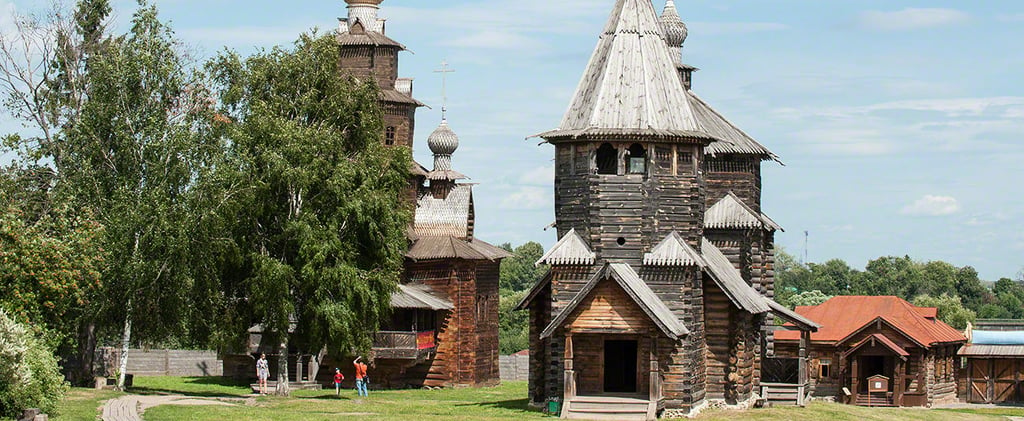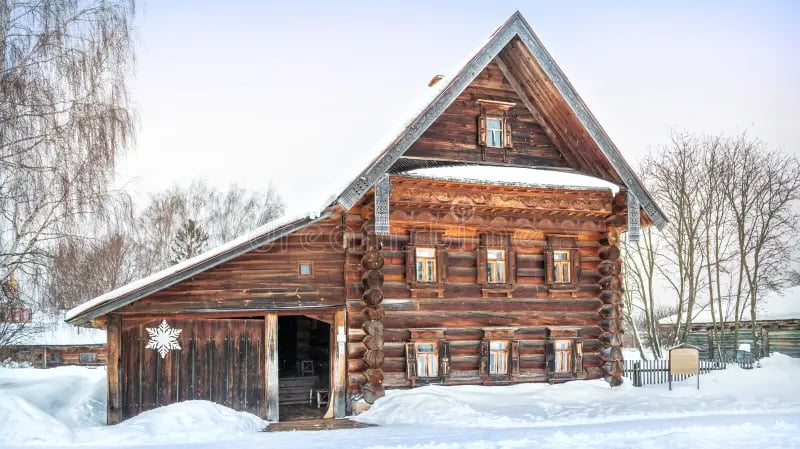Suzdal Museum of Wooden Architecture: Russia’s Timeless Village Beneath Open Skies
To enter this place is to step beyond the pace of the modern world, into a landscape of log churches, peasant cottages, windmills, and barns — each a living testament to the craft, faith, and endurance of rural Russia.


A Living Memory of Wood and Spirit
Founded in 1968, the Suzdal Museum of Wooden Architecture arose from a mission both humble and profound: to preserve the vanishing wooden heritage of the Russian countryside.
In the postwar decades, as modernization and collective farming reshaped the rural landscape, countless traditional wooden structures — churches, homes, granaries — faced neglect or demolition.
Suzdal, with its medieval kremlin and ancient monasteries, stood at the heart of a region rich in wooden architecture.
Under the vision of dedicated architects and ethnographers, a collection of endangered buildings was gathered here, on the low bank of the Kamenka River, opposite the white-stone walls of Suzdal Kremlin.
The result is not a static museum, but a reconstructed village — a space where history breathes in pine beams, where the artistry of log joinery, wood carving, and orthodox piety comes alive.
A Village of Sacred and Everyday Life
The Suzdal Museum of Wooden Architecture presents a rare holistic portrait of Russian village life — not only the sacred structures that crowned rural skylines, but also the humble dwellings and workspaces where daily existence unfolded.
Wandering its grassy lanes, visitors encounter a world shaped by rhythms of nature, craft, and faith.
Wooden Churches: Reaching Toward Heaven
The museum’s soul resides in its wooden churches, masterpieces of carpentry and devotion.
Church of the Transfiguration (18th century)
Brought here from the village of Kozlyatyevo, this soaring church exemplifies the verticality and grace of Russian wooden ecclesiastical architecture.
Its multi-tiered rooflines, crowned by a slender onion dome, draw the eye upward — an expression of the peasant community’s yearning toward the divine.
Inside, the scent of aged pine mingles with the glow of icon panels and the echo of ancient chant.
Church of the Resurrection (18th century)
Smaller and more intimate, this church reflects the regional variety of wooden sacred forms.
Its log walls, subtly curved gable ends, and finely carved porch details embody the artistry of unnamed village carpenters — artisans who built with reverence as well as skill.
Together, these churches reveal a spiritual world where wood was the chosen medium of prayer.
Peasant Houses: The Warmth of Everyday Life
Scattered across the museum grounds are authentic peasant dwellings, transported from villages across Vladimir Oblast.
Izba (Peasant House)
The heart of Russian village life was the izba — a log-built home, hewn from local pine or fir.
Inside, the visitor encounters:
The great Russian stove (pech), source of warmth, cooking, and healing.
The icon corner (krasny ugol), where family icons stood beneath embroidered cloth.
Handcrafted furniture, often adorned with floral or geometric carving.
Everyday tools — spinning wheels, loom, wooden utensils — that tell of a life rooted in self-sufficiency and craft.
Each izba offers a glimpse of a world where life followed the cycles of the seasons and the soil.
Farm Structures: The Art of the Useful
Beyond dwellings, the museum presents a remarkable array of traditional farm buildings, including:
Granaries, their elevated platforms protecting precious grain from damp and pests.
Windmills, their great arms turned by the Volga winds.
Bathhouses (banya) — humble sanctuaries of purification and community.
Barns and stables, their rugged beams shaped by necessity and craft.
In these structures, the visitor sees the ingenuity and adaptability of rural builders — a heritage of sustainable architecture crafted in harmony with nature.
The Craft of Wood: A Silent Language
At the Suzdal Museum, one learns that wood is not only material, but meaning.
The log walls of a peasant house are joined with precision dovetail notches, locking warmth within.
Porch columns are adorned with sun symbols and protective carvings, invoking blessing upon the household.
Eaves and window surrounds bear floral motifs, echoing the rhythms of field and forest.
This is a world where every element speaks — where architecture is both practical and poetic, a silent language known to generations of Russian craftsmen.
Practical Information
Location
Suzdal Museum of Wooden Architecture and Peasant Life
Kamenka River Embankment, opposite the Suzdal Kremlin
Suzdal, Vladimir Oblast, Russia
Opening Hours
Daily: 9:00 – 18:00
Hours may vary on major holidays and during special events.
Tickets
Available at the museum entrance or online.
Discounts for children, students, and seniors.
Special pricing during folk festivals.
Public Transport
Suzdal is accessible by bus or car from Vladimir (the nearest railway hub), with regular services.
Local transport and walking paths connect the town’s historic sites.
Accessibility
As an outdoor museum of historical structures, accessibility varies by building.
Museum staff assist visitors with special needs whenever possible.
Visitor Services
Guided tours in Russian, English, and other languages.
Folk festival programming throughout the year.
Artisan workshops and craft demonstrations.
Museum shop offering traditional crafts and local products.
On-site café with regional cuisine.
For current exhibitions, festivals, and visitor information:
https://www.museum-suzdal.ru
(official portal of the Vladimir-Suzdal Museum-Reserve, of which the Wooden Architecture Museum is a part)


Folk Art and Seasonal Life
The Suzdal Museum of Wooden Architecture is not merely a collection of buildings — it is a living stage for the rhythms of traditional village life.
Throughout the year, the museum hosts folk festivals, craft demonstrations, and seasonal celebrations that revive the old customs of the Russian countryside.
Maslenitsa
During Maslenitsa — the joyous festival of the Slavic sun farewell, heralding spring — the museum fills with:
The aroma of blini sizzling on wood stoves.
The bright whirl of folk dancers beneath fluttering ribbons.
The crackle of bonfires, where winter’s effigies are joyfully consumed.
Visitors join in games, sleigh rides, and ancient rites — glimpsing the deep pagan and Christian layers that shape Russian festive life.
Spas Fairs and Harvest Festivals
In late summer and autumn, the museum comes alive with harvest fairs and craft markets:
Artisans demonstrate wood carving, weaving, pottery, and lace making.
Baskets brim with apples, honey, herbs, and mushrooms — the bounty of Russian earth.
Folk choirs fill the air with ancient polyphonic songs.
In these moments, the museum bridges past and present, reconnecting modern visitors with the seasonal wisdom of their ancestors.
Educational Mission and Preservation
Beyond its role as a public attraction, the Suzdal Museum of Wooden Architecture serves as an important center for research and preservation.
Its staff includes:
Architectural historians, who document and analyze traditional building techniques.
Conservators, dedicated to maintaining the delicate fabric of aging wooden structures.
Ethnographers and folklorists, who collect and interpret the intangible cultural heritage of the region.
The museum offers:
Guided tours in Russian and multiple languages.
Lectures and workshops on folk art and rural architecture.
Collaborations with universities and heritage organizations, ensuring that the skills of traditional craftsmanship are passed on.
In this way, the museum is both a guardian of memory and a school for the future — keeping alive a knowledge that might otherwise be lost.
The Visitor’s Experience
A visit to the Suzdal Museum of Wooden Architecture is an experience of immersion — of walking through time, through space shaped by the hands of anonymous masters.
One feels:
The cool shadow of log walls beneath the summer sun.
The scent of resin and age rising from ancient beams.
The texture of hand-hewn wood beneath the fingers.
The stillness of a church where centuries of prayers linger in the air.
And always, the presence of the Russian land itself — its birch groves, meadows, and rivers — embraced by the architecture that once served its people.




